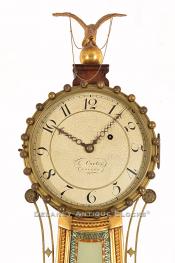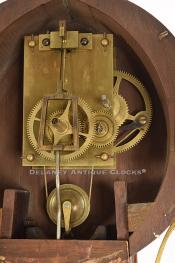Reproduction Girandole wall timepiece. This clock was possibly made by James Conlon in Boston. 221160.
This is an outstanding reproduction of a Girandole Timepiece. This form was made famous by the Concord, Massachusetts, Clockmaker Lemuel Curtis.
In 1802, Lemuel Curtis was an apprentice of the Willards in Boston. In 1811, he worked as a Journeyman and moved to Concord, MA, and set up shop as a Clockmaker specializing in timepieces. Over the years, he made several improvements to Simon Willard's original timepiece design. Examples of these are the single screw movement mounting system and changes to the clocks suspension. His ultimate achievement would have to be the design of this very attractive Girandole form. However, this form was not a financial success, and as a result, a small number of clocks were originally produced. A fair number of these original clocks are in the collections of the Country's best Museums. Many individuals and some companies have since made reproductions of this form. Some of the more prolific makers of the form include The Waltham Clock Company, Elmer Stennes, and Foster Campos.
This fine mahogany case example was made circa 1920. It was made to resemble a clock that was made by Lemuel Curtis in the 1820s. The woodwork and the patina has been messaged to simulate the look of a period clock.
James Edward Conlon (1880–1948) was an antique dealer and clockmaker/restorer who worked in Boston from the 1910s through the 1940s. He was very talented with his hands and also enjoyed researching the Clockmakers that worked a century before him. He was highly respected in the community of collectors and was eager to share his research with others. He gave lectures on the history of New England clock-making at a number of local historical societies. He lectured at a meeting of the Boston Clock Club, an organization that was formed to share information about clockmakers by their enthusiasts. Its membership excluded dealers, with the exception of Conlon. This organization describes James Conlon as someone who "has long been engaged as a clockmaker and probably has had a broader experience with fine clocks than any other person in this section. In addition to his practical experience, he has in years past devoted a great deal of time and energy to consideration of the origin and history of New England clockmakers." It is thought today that he produced a number of museum-quality copies of several early American clocks. We have seen out-of-period Willard timepieces, wall primitives, and Curtis-style girandole clocks that have been attributed to Conlon by the collectors of his day. This folklore has been passed down through the years. Closely evaluating this example certainly suggests that this may be one of his.
This very attractive clock measures approximately forty-four inches long. The frames, eagle finial, and lower bracket are wonderfully gilded in gold leaf. The gilding is in very good condition and exhibits a period patina. The other decorative elements are brass. The sidearms feature floral-style caps at both ends. The brass bezel is decorated with 24 applied balls. The reverse-painted tablets are colorful, and the execution is outstanding. The two tablets are convex or bowed. The throat is done in an intricate traditional theme. It features the word "PATENT" in a banner located in the lower section. Additional themes include an urn and a basket of fruit. The borders are excellent. The bottom circular tablet depicts a chariot scene and is titled "AURORA." This is a very popular theme but is seldom painted with this much skill. The technique, coloring, and detailing are first-rate. The convex metal dial is painted and features the L. Curtis Patent signature and traditional Concord gold ring. The hands are a traditional Curtis form having concentric circles and barbed pointers. The hour numerals are in an Arabic form. The movement is constructed in brass. It is weight powered and is designed to run for eight days on a full wind. The weight is cast iron and descends below the works in the center of the case.
This is truly a wonderful example of a beautiful clock.
Inventory number 221160.
James Edward Conlon was born in 1880 in Little Rock, Minnesota. For many years he operated a shop at 38 Providence Street in Boston as an antiques dealer and clockmaker/restorer who worked in Boston from the 1910s through the 1940s. He was trained or served his apprenticeship under George Greer in Dorchester, MA, and worked as a journeyman clockmaker for John L. Knight and the Wilson Brothers of Boston before going out alone. He was very talented with his hands and also enjoyed researching the Clockmakers that worked a century before him. He was highly respected in the community of collectors and was eager to share his research with others. He gave lectures on the history of New England clock-making at several local historical societies. He also lectured at a Boston Clock Club meeting, an organization formed to share information about clockmakers by their enthusiasts. The Boston Clock Club restricted their membership and excluded dealers. They made an exception for James Conlon. This organization describes James Conlon as someone who “has long been engaged as a clockmaker and probably has had a broader experience with fine clocks than any other person in this section. In addition to his practical experience, he has in years past devoted a great deal of time and energy to consideration of the origin and history of New England clockmakers.” He produced a number of museum-quality copies of several early American clocks.
Interestingly enough, Conlon did not sign his clocks with his name. As a result, we have seen out-of-period Willard wall primitives, timepieces, lyre clocks, lighthouse clocks, and Curtis-style girandole clocks that have been attributed to Conlon by the collectors of his day. This folklore has been passed down through the years. James E. Conlon died on December 31, 1948, at his home in Brookline, MA. He left behind his six sons and five daughters. His Son, James G. Conlon, took over the business in 1948.














